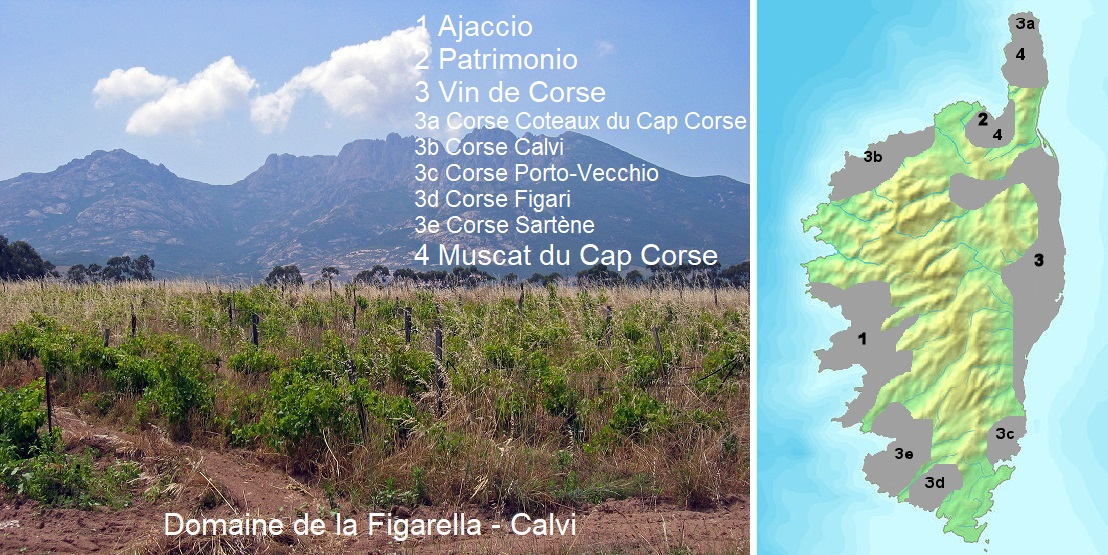Results
2,284 Results
Loading more Results ...
Loading more Results ...
Wine regions in Corsica 7 growing regions
Description to Corsica
The approximately 8,700 km² island (French: Corse) lies 160 kilometres southeast of the coast of France. In the 6th century BC, Corsica was settled by the Phoenicians, who called it Corai (covered with forest). In the middle of the 3rd century BC, the island came under Roman rule. Around 1,000 AD, Pisa gained supremacy and reactivated viticulture, which had fallen into disrepair due to the fall of the Roman Empire. Then, from the end of the 13th century, Genoa took over. Christopher Columbus (1451-1506) was probably born in Calvi on the north-western coast. In 1572, the Genoese issued a decree that each family had to plant four vines. The island was sold to France in 1768, and Napoleon (1769-1821) was born in Ajaccio a year later. As emperor, he granted his homeland the special privilege of selling wine without paying taxes. In the middle of the 19th century, there were still about 20,000 hectares of vineyards and three quarters of the population lived from winegrowing. A total decline occurred due to phylloxera.
It was not until the early 1960s that viticulture was revived by French Algerians. They planted large numbers of mass-produced varieties and Corsica became the wine lake of Europe. The EU initiated a vineyard grubbing-up in the 1980s. The mass carriers were replaced on a large scale by noble grape varieties and the vineyard area was reduced to about 7,500 hectares today. This has greatly contributed to an increase in quality. The climate is sunnier than in the mother country France, there are hot summers and sunny autumns with little rain. However, the location on the Mediterranean and the many mountains cause relatively large weather fluctuations with different climatic conditions.

50% of the wines produced are red, 40% rosé and 10% white. Important red wine varieties are Aleatico, Alicante Henri Bouschet, Barbarossa, Cabernet Sauvignon, Carcajolo Noir(Parraleta), Carignan Noir (Mazuelo), Cinsaut, Merlot, Nielluccio (Sangiovese), Sciaccarello (Mammolo) and Syrah; important white wine varieties are Biancone, Biancu Gentile, Carcajolo Blanc (Bariadorgia), Genovese (Scimiscià), Malvoisie de Corse or Vermentinu (Vermentino), Muscat Blanc and Ugni Blanc (Trebbiano Toscano). Around 70% of production is determined by large winegrowers' cooperatives. The IGP and AOC areas:
- Ajaccio (AOC)
- Corse Calvi or Vin de Corse (AOC)
- Corse Coteaux du Cap Corse or Vin de Cor se (AOC)
- Corse Figari or Vin de Corse (AOC)
- Corse Porto-Vecchio or Vin de Cor se (AOC)
- Corse Sartène or Vin de Cor se (AOC)
- Ile de Beauté (IGP)
- Méditerranée (IGP)
- Muscat du Cap Corse (AOC)
- Patrimonio (AOC)
- Vin de Corse (AOC)
Domaine de la Figarella: By Tigerente, CC BY-SA 3.0, Link
Map: By Vicenç Riullop - Own work based on Corse, Public domain, Link
find+buy for Corsica 4
Recent wines 6
 Etienne Suzzoni
— Corsica
2015 Corse Calvi AOC Clos Culombu
Up to 25.00 €
Etienne Suzzoni
— Corsica
2015 Corse Calvi AOC Clos Culombu
Up to 25.00 €

 Domaine de Pratavone
— Corsica
2015 Ajaccio AOC
Up to 20.00 €
Domaine de Pratavone
— Corsica
2015 Ajaccio AOC
Up to 20.00 €

 Domaine Fiumicicoli
— Corsica
2015 Corse Sartene AOC
Up to 20.00 €
Domaine Fiumicicoli
— Corsica
2015 Corse Sartene AOC
Up to 20.00 €

The most important grape varieties
More information in the magazine
- Plaimont - The vine rescuers from south-west France Advertisement
- Good Bordeaux doesn't have to be expensive! Crus Bourgeois
- Paradisiacal times! Tasting: European sparkling wines for the festive season
- Liv-ex classification: The fine wine market 2023 France is the measure of all things
- Domaine Combier Collection of the Year 2022 - Rhône
- The collections and discoveries of the year 2022/2023 tasting season
- Social responsibility in the name of wine In Focus: Vignerons Engagés
- AB, Vignerons Engagés, HVE, Terra Vitis: what are the differences? Organic certifications for French wine
- A lot of power for little money In Focus: Côtes du Rhône Villages Rouge
- Saving your account with pleasure In Focus: Crozes-Hermitage